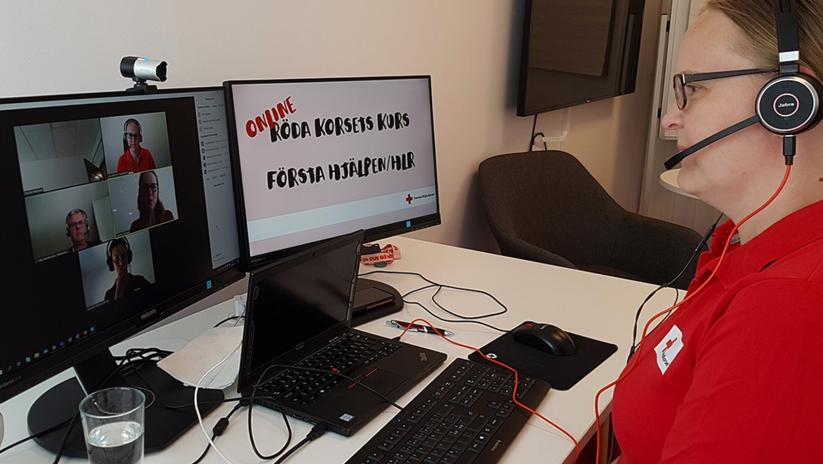
A major core activity that is offered by most National Red Cross Red Crescent (RCRC) Societies (NS) is First Aid Training In fact, first aid was one of the first services provided by the RCRC over 100 years ago. Traditionally, these training are given in person ensuring that specific techniques, such as Cardiopulmonary Resuscitation (CPR) are administered accurately. Digitally transforming such trainings is not an easy task, but still possible and proved by the experience of the Swedish Red Cross (SRC).
The Swedish Digital Journey
The Swedish Red Cross scaled up their digital transformation in 2013 with the launch of a first aid application as part of a bigger international first aid movement. Six years later, SRC launched a gamified web course called ‘Save Lives’. So far, over 300,000 learners accessed the course. Participants are presented with a number of first aid scenarios that they need to work through under a limited time frame. Fredrik Palmqvist, the Programme Development of First Aid at the Swedish Red Cross, explained how the web course came to be. He said, “as a team we were working towards a new mindset, moving from ‘we offer first aid courses’ to ‘we distribute knowledge in first aid’”. He continued to say, “if we are able to collectively have this mindset then we would be able to include new ways of distributing knowledge”. This digital shift was made possible by the inspiration and competence of the team in the SRC Learning Development Unit. first aid scenarios that they need to work through. Fredrik Palmqvist, the Programme Development of First Aid at the Swedish Red Cross, explained how the web course came to be. He said, “as a team we were working towards a new mindset, moving from ‘we offer first aid courses’ to ‘we distribute knowledge in first aid’”. He continued to say, “if we are able to collectively have this mindset then we would be able to include new ways of distributing knowledge”. This digital shift was made possible by the inspiration and competence of the team in the SRC Learning Development Unit.
Taking the Training Online
Due to the circumstances brought to the world by the COVID19 pandemic, a further step was taken to adapt the First Aid training fully online.
Palmqvist elaborated on the driving factor of this process,
we were very pragmatic. If we were not able to meet participants on site we needed to think of where we can meet them. It became very easy for the team to decide if not on-site then let us do it online
There was no other alternative present to delivering the first aid service if not transformed digitally, and work needed to continue. Taking the decision was easy, but executing it was difficult. As Palmqvist said, “we were facing our own preconceptions on how do we train first aid and CPR especially when we need a real mannequin, but given all that we had to try”. Indeed, SRC did try and were able to find alternatives to major assumptions that they had. An example of that is finding a way for participants to practice giving CPR without having to purchase a mannequin. The Learning Development Unit, with the help of a web search, were able to replicate the effects of practicing on a mannequin by using plastic bottles, towels, and a t-shirt. Now that the team knew the means of demonstrating first aid and CPR were there, the only thing left was to distribute the knowledge.
Learnings
Currently, the online course has been offered for almost a year to approximately 5000 participants and has shown to have a major impact on the readiness to act just as the onsite training has. Palmqvist spoke about the experience and the outcomes of the training. He said, “we wanted to give it a try and from what we have gathered from testimonials and focus group discussions is that it really works. Participants have reported back that they have been able to use their skills and knowledge to save someone in need”. According to Palmqvist
The team was able to distribute knowledge in a new digital way and eventually reached remote areas in Sweden that we would have not been able to reach otherwise
In addition to the digital training courses, most recently SRC opened first aid training hubs, where participants can continue their practice in these locations. At the training hubs, learners can practice on a digital mannequin that can give instant feedback and results on the administering CPR. Palmqvist later elaborated on the most important learning by saying, “you need to just give it a try, if it cannot get worse it can only get better”. With the digital transformation movement, activities and projects are looking different than what they did in the past years as change is underway. As Palmqvist said
don’t be afraid of change but rather embrace it and turn the situation into a growing learning opportunity.



